Community Development on Malnutrition in Africa
Added on 2023-06-15
33 Pages6995 Words284 Views
Running head- PUBLIC HEALTH MASTERS
Community development on malnutrition in Africa
Name of the Student
Name of the University
Author Note
Community development on malnutrition in Africa
Name of the Student
Name of the University
Author Note
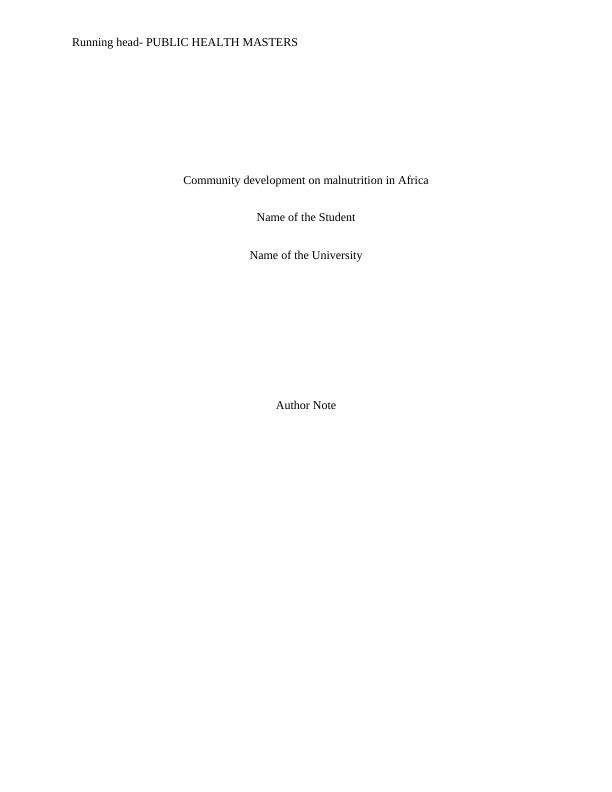
1PUBLIC HEALTH MASTERS
Executive summary
Malnutrition occurs in all forms, such as, overweight or under-nutrition. It presents significant
threats, and challenges, to the human health. At present, the world is facing a double burden of
malnutrition, which can be attributed to the high rates of overweight children in developed
countries, and under-nourished children in developing countries. Inadequate nutrition and hunger
have been found to contribute to higher rates of mortality that result in maternal and children
death. It also leads to impairment in the brain and physical development of infants. Furthermore,
this inadequate nutrient intake is correlated with several chronic illnesses and infectious diseases.
All of these conditions are life-threatening and extremely difficult to apply proper intervention,
in regions such as, Africa that has limited resources and overburdened health systems. Efforts
have been taken to reduce these rates of under-nutrition in several countries of Africa. The report
will critically evaluate research articles that elaborate on the interventions.
Executive summary
Malnutrition occurs in all forms, such as, overweight or under-nutrition. It presents significant
threats, and challenges, to the human health. At present, the world is facing a double burden of
malnutrition, which can be attributed to the high rates of overweight children in developed
countries, and under-nourished children in developing countries. Inadequate nutrition and hunger
have been found to contribute to higher rates of mortality that result in maternal and children
death. It also leads to impairment in the brain and physical development of infants. Furthermore,
this inadequate nutrient intake is correlated with several chronic illnesses and infectious diseases.
All of these conditions are life-threatening and extremely difficult to apply proper intervention,
in regions such as, Africa that has limited resources and overburdened health systems. Efforts
have been taken to reduce these rates of under-nutrition in several countries of Africa. The report
will critically evaluate research articles that elaborate on the interventions.
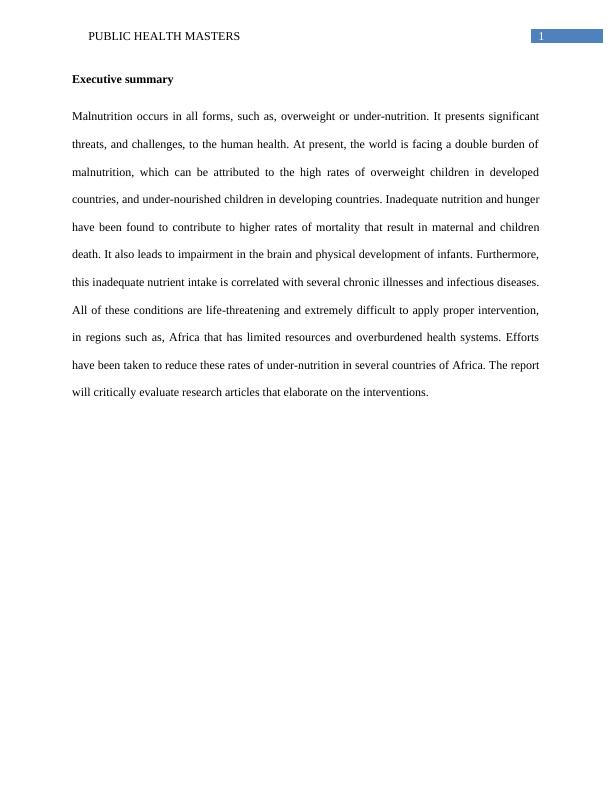
2PUBLIC HEALTH MASTERS
Table of Contents
Introduction......................................................................................................................................3
Discussion........................................................................................................................................3
Literature review..........................................................................................................................5
Analysis of the articles.................................................................................................................6
Recommendations and Conclusion................................................................................................14
Research question..........................................................................................................................15
References......................................................................................................................................15
Appendix 1.....................................................................................................................................20
Appendix 2.....................................................................................................................................21
Table of Contents
Introduction......................................................................................................................................3
Discussion........................................................................................................................................3
Literature review..........................................................................................................................5
Analysis of the articles.................................................................................................................6
Recommendations and Conclusion................................................................................................14
Research question..........................................................................................................................15
References......................................................................................................................................15
Appendix 1.....................................................................................................................................20
Appendix 2.....................................................................................................................................21

3PUBLIC HEALTH MASTERS
Introduction
Millions of people living in Africa lack the basic human needs that can be attributed to
poverty. The nation is generally ranked low, with regards to economic growth and development.
The small task According to research studies, poverty, in addition to lack of infrastructure,
gender inequality and AIDS create significant impacts on hunger in Africa. While there is plenty
of food in some regions, lack of reliable pathways for delivering the food to the vulnerable and
disadvantaged people contribute to hunger, and subsequent under-nutrition (Gohou and Soumaré
2012). Similarly, gender inequality plays an essential role because there is a tendency to deliver
more food to women. AIDS also renders the community members of rural regions too sick to
participate in agricultural activities, thereby resulting in their failure to acquire food (Justesen
and Bjørnskov 2014). The assignment will illustrate several strategies and frameworks that have
been formulated as a part of community development to address the severe issue of malnutrition
in Africa.
Discussion
Malnutrition can be defined as the condition that arises when an individual consumes diet
that does not contain adequate proportion of the nutrients, needed by the body. Commonly
encompassing overweight and under-nutrition, malnutrition is a global issue and presents a
plethora of threats to health (Neis, Zielstra and Zipf 2013).
According to research reports, the continent is under serious nutrition related threats that
stem from deficiency in nutrients in the diet. Despite an reduction in prevalence of stunting on a
Introduction
Millions of people living in Africa lack the basic human needs that can be attributed to
poverty. The nation is generally ranked low, with regards to economic growth and development.
The small task According to research studies, poverty, in addition to lack of infrastructure,
gender inequality and AIDS create significant impacts on hunger in Africa. While there is plenty
of food in some regions, lack of reliable pathways for delivering the food to the vulnerable and
disadvantaged people contribute to hunger, and subsequent under-nutrition (Gohou and Soumaré
2012). Similarly, gender inequality plays an essential role because there is a tendency to deliver
more food to women. AIDS also renders the community members of rural regions too sick to
participate in agricultural activities, thereby resulting in their failure to acquire food (Justesen
and Bjørnskov 2014). The assignment will illustrate several strategies and frameworks that have
been formulated as a part of community development to address the severe issue of malnutrition
in Africa.
Discussion
Malnutrition can be defined as the condition that arises when an individual consumes diet
that does not contain adequate proportion of the nutrients, needed by the body. Commonly
encompassing overweight and under-nutrition, malnutrition is a global issue and presents a
plethora of threats to health (Neis, Zielstra and Zipf 2013).
According to research reports, the continent is under serious nutrition related threats that
stem from deficiency in nutrients in the diet. Despite an reduction in prevalence of stunting on a
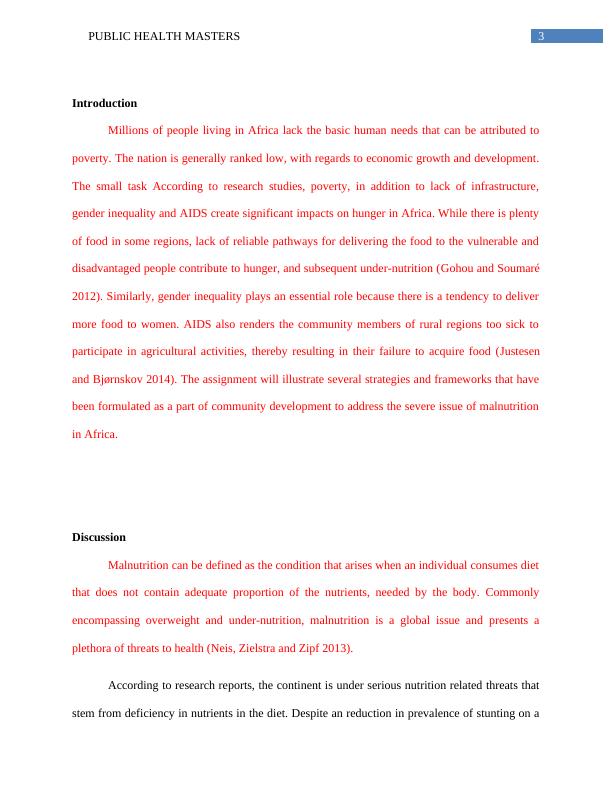
4PUBLIC HEALTH MASTERS
global scale, more than 60 million African children, under the age of 5 years demonstrate poor
growth and development. Recent reports from the WHO indicate that the issue is still persistent
in the region, which thereby contributes to an increase the number of undernourished children
(Horton and Steckel 2013). The major factors that contribute to under-nutrition are population
growth, limited resources for purchasing food and mounting food wastes. This lack of nutritious
food items creates a significant impact on the infrastructure development and economic progress
of the nation, in addition to human wellbeing. African nations are found to lag behind on
attaining appropriate physical and mental capacities for the population due to under-nutrition. An
increase in mortality rates, chronic illnesses, and loss of productivity contribute to this condition
(Chan et al. 2012). Thus, it can be stated that improving the dietary intake and ending
malnutrition in the nation will greatly help in reversing the problem. The African government
and non-governmental organizations have adopted several strategies with the aim of formulating
productive and sustainable measures that will counteract the issue of malnutrition and enhance
the overall growth and wellbeing of all individuals.
According to statistical data, about 1 in 12 children living in the sub-Saharan regions of
Africa suffer from malnutrition. The World Bank reports state that approximately 17.6 million
children living in the region are affected with acute malnutrition (Bain et al. 2013). Furthermore,
there was an increase in the number of stunted children, between the years 1990-2014, by
approximately 20 million. Further reports from the WHO also suggest that Africa demonstrates
the highest risk of a child dying before the first birthday (Grace et al. 2012). Research findings
also illustrate the fact that more than 6.7 million people die each year in Africa due to hunger ( de
Sherbinin 2011). Health promotion is defined as the process that enables individuals to improve
and increase their control over their health status. It focuses on a range of environmental and
global scale, more than 60 million African children, under the age of 5 years demonstrate poor
growth and development. Recent reports from the WHO indicate that the issue is still persistent
in the region, which thereby contributes to an increase the number of undernourished children
(Horton and Steckel 2013). The major factors that contribute to under-nutrition are population
growth, limited resources for purchasing food and mounting food wastes. This lack of nutritious
food items creates a significant impact on the infrastructure development and economic progress
of the nation, in addition to human wellbeing. African nations are found to lag behind on
attaining appropriate physical and mental capacities for the population due to under-nutrition. An
increase in mortality rates, chronic illnesses, and loss of productivity contribute to this condition
(Chan et al. 2012). Thus, it can be stated that improving the dietary intake and ending
malnutrition in the nation will greatly help in reversing the problem. The African government
and non-governmental organizations have adopted several strategies with the aim of formulating
productive and sustainable measures that will counteract the issue of malnutrition and enhance
the overall growth and wellbeing of all individuals.
According to statistical data, about 1 in 12 children living in the sub-Saharan regions of
Africa suffer from malnutrition. The World Bank reports state that approximately 17.6 million
children living in the region are affected with acute malnutrition (Bain et al. 2013). Furthermore,
there was an increase in the number of stunted children, between the years 1990-2014, by
approximately 20 million. Further reports from the WHO also suggest that Africa demonstrates
the highest risk of a child dying before the first birthday (Grace et al. 2012). Research findings
also illustrate the fact that more than 6.7 million people die each year in Africa due to hunger ( de
Sherbinin 2011). Health promotion is defined as the process that enables individuals to improve
and increase their control over their health status. It focuses on a range of environmental and
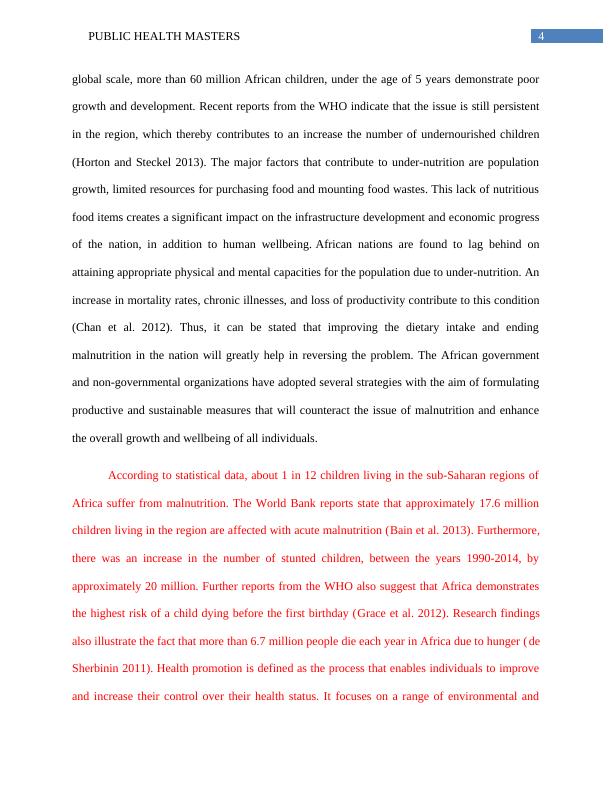
5PUBLIC HEALTH MASTERS
social interventions. Socio-economic differences directly influence the educational attainment,
occupational status, and income. The social determinants of health are most often amenable to a
range of political interventions and depend on political action (Ahnquist, Wamala and Lindstrom
2012). Health promotion strategies are governed by the politics of the nation because wellbeing
and good health are the basic aspects of human rights and citizenship (Savedoff et al. 2012).
Cultural aspects of a the residents also influence health promotion owing to the wide plethora of
existing experience and knowledge, regarding health promotion and disease prevention that
exists among the culturally diverse populations (Mackenbach 2012). Thus, it can be stated that
these factors play a major role in the adoption of effective health promotion strategies.
Literature review
The primary aim of PRISMA is to evaluate the interventions that have been applied in the
context of research. It acts as an essential critical appraisal tool that facilitates the quality
assessment of the selected literature, thereby assisting in gauging the reliability and effectiveness
of the research findings (Stovold et al. 2014). Thus, the PRISMA acts as a broader effort for
improving the reporting of various kinds of healthcare based research. The PRISMA flow
diagram helps in depicting the flow of relevant information through a wide variety of stages that
are imperative for a systematic review. The diagram assists in mapping out the records that have
been identified, excluded or included in the search. The diagram also explains the probable
reasons for exclusion of the articles. The major themes for the literature review include
nutritional capacity assessment, nutritional feeding or therapeutic feeding programs, integrative
protocol, and community management strategies.
Relevant research articles were extracted from PubMed databases by using specific key
words such as, “child”, “children”, “malnutrition”, “under-nutrition”, “prevention”, “reduce”,
social interventions. Socio-economic differences directly influence the educational attainment,
occupational status, and income. The social determinants of health are most often amenable to a
range of political interventions and depend on political action (Ahnquist, Wamala and Lindstrom
2012). Health promotion strategies are governed by the politics of the nation because wellbeing
and good health are the basic aspects of human rights and citizenship (Savedoff et al. 2012).
Cultural aspects of a the residents also influence health promotion owing to the wide plethora of
existing experience and knowledge, regarding health promotion and disease prevention that
exists among the culturally diverse populations (Mackenbach 2012). Thus, it can be stated that
these factors play a major role in the adoption of effective health promotion strategies.
Literature review
The primary aim of PRISMA is to evaluate the interventions that have been applied in the
context of research. It acts as an essential critical appraisal tool that facilitates the quality
assessment of the selected literature, thereby assisting in gauging the reliability and effectiveness
of the research findings (Stovold et al. 2014). Thus, the PRISMA acts as a broader effort for
improving the reporting of various kinds of healthcare based research. The PRISMA flow
diagram helps in depicting the flow of relevant information through a wide variety of stages that
are imperative for a systematic review. The diagram assists in mapping out the records that have
been identified, excluded or included in the search. The diagram also explains the probable
reasons for exclusion of the articles. The major themes for the literature review include
nutritional capacity assessment, nutritional feeding or therapeutic feeding programs, integrative
protocol, and community management strategies.
Relevant research articles were extracted from PubMed databases by using specific key
words such as, “child”, “children”, “malnutrition”, “under-nutrition”, “prevention”, “reduce”,

6PUBLIC HEALTH MASTERS
“strategies”, “community development”, “framework”, “Africa”. Several boolean operators such
as, AND, OR, and NOT were used to narrow down the search and exclude articles that were
irrelevant to the topic of interest. Articles that were published in English, not prior to 2011, were
selected for the analysis. Unpublished articles, abstracts and articles published before 2011 were
excluded. Fourteen articles were enlisted (refer to appendix for PRISMA flow chart).
Database PubMed
Total number of hits after search 228
Records that were identified after thorough
search
58
Number of duplicates 26
Excluded articles 12
Full text articles that were extracted 14
Table 1- Summary showing database search results
Analysis of the articles
Theme 1: Nutritional capacity assessment
A framework developed by (Shrimpton et al. 2014) was based on building the nutritional
capacity for addressing the needs of child and mother malnutrition. The methodology was
appropriate due to the fact that capacity refers to the ability to conduct the predetermined
objectives and the procedure by which groups, individuals or organisations are able to increase
their problems solving ability. The researchers demonstrated an appropriate practice in building
the concept on existing approaches. Furthermore, the research focused on the operational effects
“strategies”, “community development”, “framework”, “Africa”. Several boolean operators such
as, AND, OR, and NOT were used to narrow down the search and exclude articles that were
irrelevant to the topic of interest. Articles that were published in English, not prior to 2011, were
selected for the analysis. Unpublished articles, abstracts and articles published before 2011 were
excluded. Fourteen articles were enlisted (refer to appendix for PRISMA flow chart).
Database PubMed
Total number of hits after search 228
Records that were identified after thorough
search
58
Number of duplicates 26
Excluded articles 12
Full text articles that were extracted 14
Table 1- Summary showing database search results
Analysis of the articles
Theme 1: Nutritional capacity assessment
A framework developed by (Shrimpton et al. 2014) was based on building the nutritional
capacity for addressing the needs of child and mother malnutrition. The methodology was
appropriate due to the fact that capacity refers to the ability to conduct the predetermined
objectives and the procedure by which groups, individuals or organisations are able to increase
their problems solving ability. The researchers demonstrated an appropriate practice in building
the concept on existing approaches. Furthermore, the research focused on the operational effects
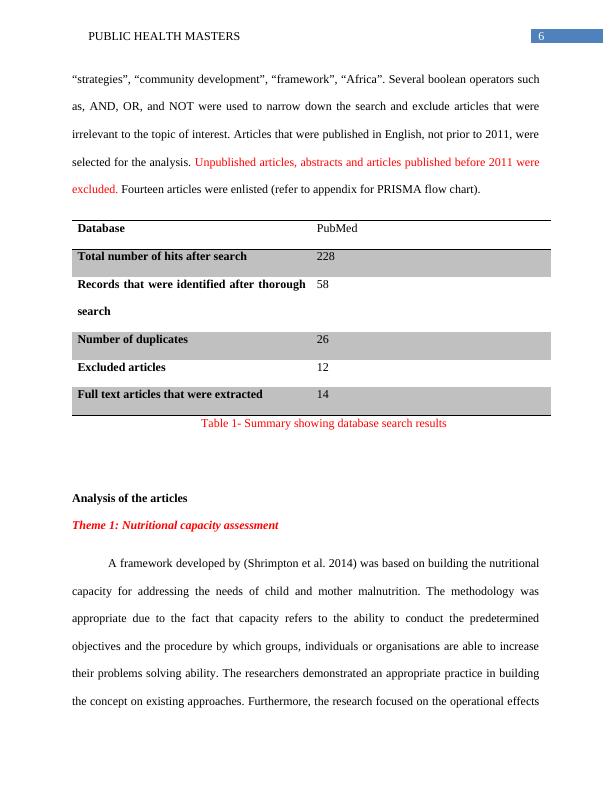
7PUBLIC HEALTH MASTERS
of system, organizational, workforce and community level on nutritional assessment of the
community. The methodology acknowledged the importance of involving beneficiaries to
improve nutrition. It also illustrated the role of population coverage, village organizational
structure, community ownership and proper training to improve the nutritional needs. Issues
were associated with superficial conceptualizations of capacity development.
Theme 2: Nutrition feeding/therapeutic feeding
Another research study (Tomedi et al. 2012) was conducted with the aim of determining
the effectiveness and feasibility of locally available food supplementation to prevent child
malnutrition in Kenya. The research study was accurate in the way that it focused on the rural
population that had higher rates of child under-nutrition. The methodology can be stated accurate
due to the fact that food supplementation has been earlier proved to increase the amount to
nutrients in the normal diet among people suffering from its deficit. Furthermore, the researchers
focused on administering essential nutrients to the undernourished children. Thus, distribution of
food ration on a monthly basis was a necessary step that facilitated consumption of essential
proteins, vitamins and minerals, required by children in their growth years. Moreover,
conducting educational sessions on appropriate food handling and hand washing techniques were
also needed for preventing any adverse health effects.
The nutrition intervention programs that focused on malnutrition were assessed by
another study (Iversen et al. 2012). This demonstrated a correct methodology due to the fact that
the primary aim of these programs was related to alleviating malnutrition among the young
population. The primary drawback of these intervention programs was the fact that they failed to
address the nutritional needs of the blacks and other disadvantaged population. The research was
of system, organizational, workforce and community level on nutritional assessment of the
community. The methodology acknowledged the importance of involving beneficiaries to
improve nutrition. It also illustrated the role of population coverage, village organizational
structure, community ownership and proper training to improve the nutritional needs. Issues
were associated with superficial conceptualizations of capacity development.
Theme 2: Nutrition feeding/therapeutic feeding
Another research study (Tomedi et al. 2012) was conducted with the aim of determining
the effectiveness and feasibility of locally available food supplementation to prevent child
malnutrition in Kenya. The research study was accurate in the way that it focused on the rural
population that had higher rates of child under-nutrition. The methodology can be stated accurate
due to the fact that food supplementation has been earlier proved to increase the amount to
nutrients in the normal diet among people suffering from its deficit. Furthermore, the researchers
focused on administering essential nutrients to the undernourished children. Thus, distribution of
food ration on a monthly basis was a necessary step that facilitated consumption of essential
proteins, vitamins and minerals, required by children in their growth years. Moreover,
conducting educational sessions on appropriate food handling and hand washing techniques were
also needed for preventing any adverse health effects.
The nutrition intervention programs that focused on malnutrition were assessed by
another study (Iversen et al. 2012). This demonstrated a correct methodology due to the fact that
the primary aim of these programs was related to alleviating malnutrition among the young
population. The primary drawback of these intervention programs was the fact that they failed to
address the nutritional needs of the blacks and other disadvantaged population. The research was

End of preview
Want to access all the pages? Upload your documents or become a member.
Related Documents
(PDF) A descriptive study on Malnutritionlg...
|16
|4072
|20
Improving Nutritionlg...
|10
|2038
|31
Nutrition Science And Application 2022lg...
|10
|1929
|25
Malnutrition in Indialg...
|5
|877
|415
Understanding the Impact of Unhealthy Nutrition and Obesity: Global Epidemic and Prevention Strategieslg...
|16
|1296
|222
Introduction to Healthcare in Australialg...
|7
|1549
|19